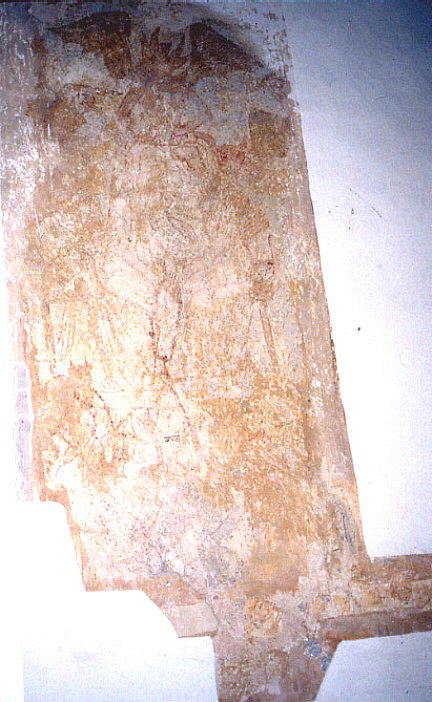Seething, Norfolk (†Norwich) C.14
The Warning Against Idle Gossip

I do not know whether a skilled restorer could do much with this painting in its present state, but without intervention it will not be visible for much longer. Despite its very faded state, though, I have included it here as the subject, few examples of which remain, is of such interest for the social and religious history of the Middle Ages.
Careful scrutiny – ‘getting your eye in’ – is needed to make the sketchy lines to which it has been reduced meaningful, but the horned head, wings and shoulders of a devil at the top of the painting should emerge. His elbows, flexed in much the same way as those of the devil at Peakirk, also show, and like his Peakirk counterpart he is holding the heads of two women together as they gossip intimately below. These heads, in plain whitish headdresses like those of the gossiping women at Slapton, will reveal themselves to an accustomed eye, as will some of the rest of their figures. Both women are seated on a bench of some kind, two legs of which can be made out at the corners. They are sitting very closely together, knee to knee – this is certainly a very confidential huddle, encouraged by the devil above.
A small horned devil, identified by EW Tristram as the industrious Titivillus, who is discussed in the Introduction to this subject, appears at the bottom left. In this newer photograph it is now just possible to see that one of the women is dangling a rosary, appearing as an oval red outline in the centre of the scene, and Titivillus has another. It may be hanging around his neck, and the implication is that he has stolen it from one of these inattentive women. Tristram also saw “part of an inscription consisting of apparently meaningless arrangments of similar letters, frequently repeated”¹. It is just possible now to make out a letter C, between the right shoulder of Titivillus and the leg of the bench above him. There have at some earlier stage been other subsidiary figures here, presumably helping to pick up the ‘dropped’syllables (Introduction), but only a few confused traces remain now.
I hope the painting can be rescued, because there are suggestions that it was originally quite an accomplished example. The way in which the two women are disposed on the bench, with thighs curving in a well-observed naturalistic manner (and the feet of the woman on the left crossed at the ankles, I think) compares favourably with the rather clumsier articulation of the figures at Slapton, for example.
There are other paintings at Seething, including a Passion Cycle.
Website for Friends of Seething church
¹ Tristram III, p.245
† in page heading = Diocese